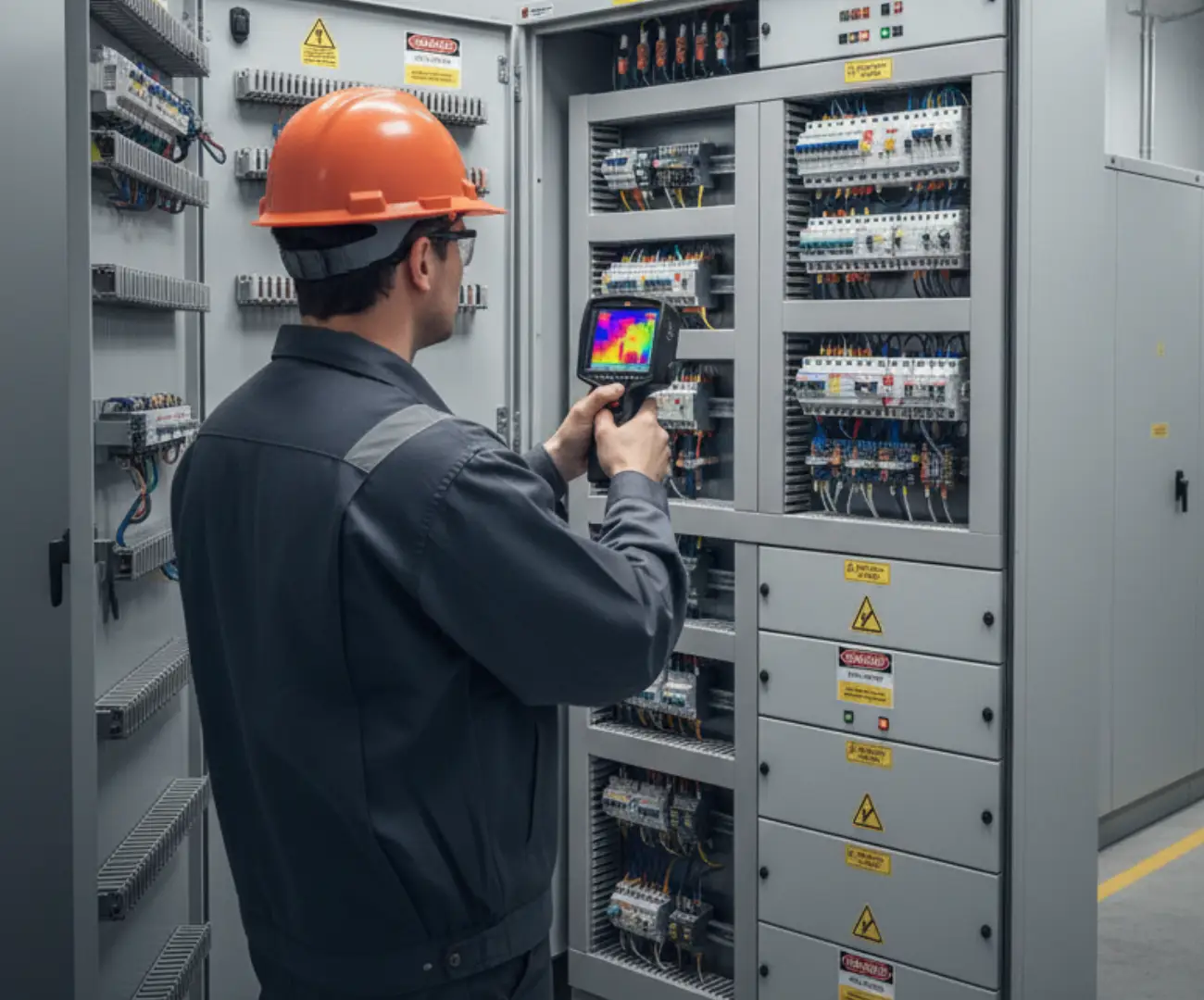
Infrared (IR) testing is more than just a compliance box to check — it’s one of the smartest investments facility managers can make. By using thermal imaging cameras to detect abnormal heat in electrical equipment, IR testing uncovers hidden issues that, left untreated, can lead to breakdowns, safety hazards, and costly downtime.
Under NFPA 70B (2023), annual IR inspections are now a required component of electrical maintenance programs. But beyond compliance, IR testing delivers measurable financial benefits. Here are the top five ways it saves money for your facility.
Few things are more expensive than an unexpected shutdown. In manufacturing, downtime can cost hundreds of thousands of dollars per hour. Healthcare facilities, data centers, and commercial operations face similar high stakes.
Infrared testing identifies hot spots, loose connections, and overloaded circuits before they fail — preventing unplanned outages that disrupt operations.
Every hour of downtime avoided is money saved.
Overheated components don’t just fail — they damage the systems around them. When switchgear, motors, or circuit breakers are pushed beyond safe operating conditions, the cost of emergency replacement can skyrocket.
IR testing pinpoints stress points early, allowing for corrective repairs that extend equipment lifespan and reduce capital replacement expenses.
Hot spots aren’t just a safety hazard — they’re a sign of inefficiency. Overloaded circuits, unbalanced loads, and loose connections all waste energy.
By identifying and correcting these inefficiencies, infrared testing improves overall energy performance, reducing utility bills. The savings may seem small at first, but over time they add up significantly.
IR testing uncovers hidden energy waste you’re paying for every month.
Compliance with electrical safety standards isn’t optional.
- OSHA (Occupational Safety and Health Administration) requires employers to maintain equipment in safe operating condition under 29 CFR 1910 Subpart S.
- NFPA 70B (2023) requires annual infrared thermography inspections as foundational predictive maintenance.
- NFPA 70E (2024) connects IR testing into arc flash and electrical safety risk assessments.
Failure to comply can result in OSHA fines of up to $16,000 per violation, with willful or repeat violations reaching over $160,000. Infrared testing provides the documented proof you need for audits and inspections — helping you avoid costly citations.
For real-world examples of companies that faced significant penalties, visit our blog The Cost of Non-Compliance.
Insurance carriers recognize infrared testing as a proven way to reduce risk. Many require it for high-risk facilities such as manufacturing plants and hospitals.
Documented IR reports can:
- Lower insurance premiums.
- Demonstrate proactive risk management.
- Strengthen your defense in the event of a claim.
Insurers see IR testing as proof you take risk seriously.
Without IR Testing
A loose breaker connection overheats, fails unexpectedly, and takes out a production line.
Result = thousands in emergency repairs and lost output.
With IR Testing
The same breaker is identified during a scheduled inspection, repaired during planned downtime, and replaced at standard cost.
Result = minimal expense and zero production loss.
Infrared testing works best as part of a holistic electrical maintenance strategy:
- One-Line Diagrams: Keep distribution system drawings updated for safety and planning.
- Preventive Maintenance: Cleaning, lubricating, and torquing ensure safe connections.
- Arc Flash Hazard Analysis: Aligns with NFPA 70E for risk assessments and PPE requirements.
- Electrical Maintenance Programs (EMP): NFPA 70B now requires documented EMPs for compliance.
C&H Electric helps facilities combine these elements into a single, integrated program.
Infrared testing delivers the greatest value when it’s integrated into a broader Electrical Maintenance Program (EMP). A single scan provides insight, but pairing IR testing with other maintenance practices creates a complete strategy for compliance and reliability.
Key elements include:
- One-Line Diagrams: Keeping electrical distribution drawings updated ensures safety, accurate troubleshooting, and effective planning.
- Preventive Maintenance: Routine cleaning, lubricating, and torquing connections reduce risks that IR testing often identifies.
- Arc Flash Hazard Analysis: Required under NFPA 70E, this analysis uses IR results to refine risk assessments and PPE requirements.
- Electrical Maintenance Programs (EMP): As mandated by NFPA 70B (2023), facilities must now have a documented plan that includes IR testing as a predictive maintenance tool.
Ready to Cut Costs with IR Testing?
Don’t wait for failure to disrupt your operations. Partner with C&H Electric to make infrared testing part of your preventive maintenance strategy